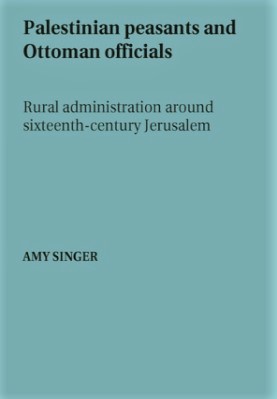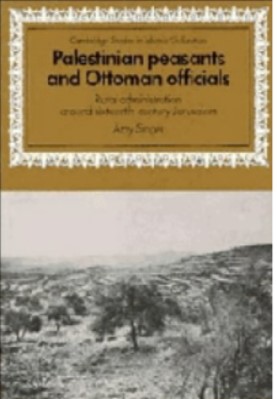Palestinian Peasants and Ottoman Officials: Rural Administration around Sixteenth-Century Jerusalem

| Palestinian Peasants And Ottoman Officials |
| Amy Singer |
| 221 |
| |
| PDF Direct Link |
| Click for Copy from Amazon |
A Monetary History of the Ottoman Empire
PALESTINIAN PEASANTS AND OTTOMAN OFFICIALS – Book Sample
Intro – PALESTINIAN PEASANTS AND OTTOMAN OFFICIALS –
On August 9, 1555, Ilyas sipahi (cavalry officer), acknowledged before the kadi of Jerusalem that he had received 19 gold dinars and 35 silver pieces from the villagers of ‘Ayn Silwan.
The peasants had owed him a total of 27 gold dinars as taxes on the revenues from their annual crops and therefore a debt of 7 gold dinars and 5 silver pieces remained outstanding.1 Ali of this was carefully noted in the kadi’s ledger.
In December 1554, Nasif sipahi sued Ahmad of the village of Bayt Dhakariyya, which was part of Nasif’s tımar (income grant), claiming that Ahmad had been living in another village for two years although he was registered among the peasants of Bayt Dhakariyya.
When the district survey register was produced before the kadi in Ahmad’s presence, it confirmed Nasif’s daim and he thus requested that Ahmad be required to return to Bayt Dhakariyya. Ahmad, for his part, claimed that he could prove his residence in the other village but then conceded that he was stili legally a resident of Bayt Dhakariyya, having left the village only three years earlier. Whereupon the kadi ordered him to return to his village and pay his back tax.es to Nasif.2
Seven peasants who cultivated lands around Jerusalem came before the kadi on July 11, 1553 and sued Mehmet, the official responsible for the immediate surroundings of the city. They claimed that he was abusive and illegally levied arbitrary amounts of grain and straw from their threshing floors.
Mehmet maintained that they had voluntarily donated the grain and straw to him, but the peasants insisted that he had forced them to hand it over and they produced two more witnesses to attest to this fact. The kadi ordered that Mehmet be prevented from such acts in future.3
Each of these three cases from the Muslim court of Jerusalem involved an Ottoman official, the kadi of Jerusalem, and one or more local peasants.
As was often the case, peasants were brought by officials to settle accounts or else they came seeking redress against the abuses of these same officials. The kadi heard the facts of the case, issued a judgment and determined the fine or punishment required. in the Ottoman provincial regime, one important function of the kadi was to serve as an arbiter between the military and fiscal administrators, and the local population. His jurisdiction ranged from the mundane mediation and cataloguing of debts and payments to much more dramatic incidents of abuse and wrongdoing.
Local peasants were not a rare curiosity in the kadi’s chambers. The ledger entries of the Jerusalem kadi recorded hundreds of cases which exposed the details of peasant-official relations during the period of Ottoman rule.
Peasants, millions of people living in Anatolia, the Balkans, Eastern Europe, the Fertile Crescent, Egypt, and North Africa, were the majority population of the Ottoman empire. In official chronicles they figure most often – if at all – as the backdrop to the great persons and events of imperial history. In official documents, peasants appear as lists of taxpayers, trans muted into quantities of grain, oil, meat, fruit, or silver coins. The villages and villagers filled in as grey between the colors of the great cities and provincial towns, below and around the ruling elite, the military, religious and commercial notables, the urban populace and the nomads.
Yet the peasant populations were one foundation of the Ottoman empire, an integral component of its strength. Mostly Muslims and Christians, they formed the bulk of the re’aya, the taxpaying class. Their agricultural labors were the hasis of the state’s wealth, producing subsistence for themselves and reve nues for the ruling askeri class, the military, administrative and religious functionaries.
From the perspective ofa lifetime of research, Halil Inalcik has said:
the peasant faınily labor farın, which was the cell of the socio-economic structure in most of the so-called Asiatic empires, determined the formation and was responsible for the survival of these empires … in fact, if we reverse our usual point of view, it would be no exaggeration to call them peasant empires … it is our contention that without open or tacit support of the peasant masses, the Ottoman empire could not have come into existence and could not have survived. in other words, it was a comproınise that gave rise to this particular polity.4
What sort of a compromise was it which obtained “the open or tacit support of the peasant masses”? Inalcik implies that the compromise was made possible by the very nature of Ottoman administration, specifically the agrarian regime.
There was, however, no great historic negotiation which mediated this arrangement, a meeting at long tables with the peasants on one side, and the sultan and his men on the other. The settlement was essentially imposed from above, by force when necessary. However, the compromise was continually and implicitly renegotiated to produce a temporary equilibrium between the forces and needs of the administration and the forces and needs of the local agrarian, taxpaying populations, in any particular place, for any given month or year or decade.
Compromise and equilibrium, however, sound both tranquil and vague. Abuse and unrest were to be found at opposite ends of the spectrum of official-peasant relations, and could escalate to cruel oppression and out right revolt. Indeed, peasants have most often figured prominently in historic annals as the victims of oppression or the heroes/villains of insurrection.
Yet it was not always in such instances that the peasants were most successful at affecting their situations. Rather, the more routine actions of these millions, individual acts on a minute scale, added up to influence the nature of government. Through them the peasants negotiated their side of the nebulous compromise.
The Palestinian peasants were incorporated into the imperial network of Ottoman provincial administration with the conquests of the early sixteenth century. Names of villages familiar to local residents even today were first recorded in the Ottoman tax registers around 1520. This process was not abrupt or disjunctive, but was part of the gradual integration of the Arab provinces into the Ottoman empire, thereby informing another aspect of the underlying compromise.
Ottoman provincial administrative mechanisms did not replace existing structures of local government and taxation in conquered areas. Initially, they imposed only a general framework; gradually Ottoman practices were introduced, simultaneously incorporating useful and appropriate aspects of local custom. The resulting administration was clearly Ottoman, adapted to suit local conditions.
This book explores the relationship between provincial officials and local peasants in order to analyze the day-to-day workings of Ottoman rural administration. It concentrates, as far as possible, on the village and the villagers, how the peasants responded to officials and how they were treated by these representatives of the imperial administration.
The aim is to attain a perspective of rural administration closer to that of the peasants themselves, both its immediate personification and its imperial persona, and to build a new empirical basis for understanding the actual administration of the countryside. Having done this, one must further ask, to what extent the administration of Palestine typified Ottoman provincial administration of the period. Finally, any reconsideration of peasant-official relations implies a re-evaluation of our conception of Ottoman imperial authority and its relations with the societies which maintained it.
Palestine and the Ottoman Empire
When the Ottomans conquered the lands of the Fertile Crescent and Egypt from the Mamluks in the early sixteenth century, the Mamluk provinces (n(yii.biit) of Gaza and Safad were often provincial outposts and places of exile for unruly coınmanders in the Cairo-based empire. Under the Mamluks, Jerusalem had been part of the province centered on the town of Gaza.
The Mamluk sultan preferred to banish his commanders to Jerusalem because the region was isolated, yet nearby, and lacked a strong garrison or fort from which to base a revolt. The commanders themselves favored Jerusalem asa place of exile for its climate and the concentration of religious sites and scholars there.5
These southem provinces of Syria were vividly described in fifteenth century writings. 6 Bedouin raiding was a chronic problem, plaguing loca! residents and travelers alike. For ten years at the beginning of the sixteenth century, the Muslim pilgrimage to Mecca (IJ,ajj) was impossible from Jeru salem due to Bedouin brigandage on the road leading south from the city.7
Nor did the Mamluk sultan have complete control over his own officers here. The frequent change of govemors wore on the loca! population as each one successively sought to reimburse his private treasury for the price of his govemorship. By the fifteenth century, the loca! Jerusalem economy was depressed due to a general lack of income. The city was populated by “the poor and the pious,” Muslims, Christians, and Jews alike.
Even the many vakıfs (pious foundations) which had been created to support Muslim schools were impoverished. 8 Jerusalem itself was not an important econornic center, and lay off the official post and regular coastal trade route from Damascus to Egypt through Gaza. People there subsisted on meager earn ings from agriculture, or employ in basic services and manufactures.9
In 1516-17, the Ottoman sultan Selim I (1512-20) led his army in a rapid campaign south from Anatolia through Syria to Egypt and the Hejaz, incorporating the provinces of the Mamluk empire into the Ottoman empire. Selim’s conquest was a continuation of the policies…
To read more about the Palestinian Peasants And Ottoman Officials book Click the download button below to get it for free
Report broken link
Support this Website

 Don't Miss out any Book Click Join OpenMaktaba Telegram group
Don't Miss out any Book Click Join OpenMaktaba Telegram group